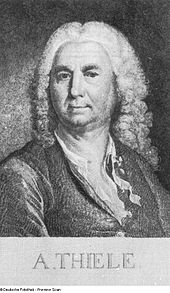Johann Alexander Thiele

Johann Alexander Thiele (born March 26, 1685 in Erfurt , † May 22, 1752 in Dresden ) was a German painter and etcher .
Live and act

After a five-year apprenticeship as a book printer in his native Erfurt , Thiele married Clara Benigna Dönicke in Arnstadt in 1710 . In 1715 Thiele went to Dresden as a self-taught copyist of landscape paintings , where he learned from Adam Manyoki . He depicted a Carnival Comique in the Dresden Zwinger in 1722 in his first pictures. Many of his subsequent paintings were for the Saxon Minister Jacob Heinrich von Flemming and his collection.
When Flemming died as a client in 1728, Thiele went back to Arnstadt. In 1729 he became court painter to Prince Günther I of Schwarzburg-Sondershausen and also worked for the courts in Braunschweig and Kassel . Shortly before his death in 1740, Thiele became a new patron with Count Heinrich von Brühl , and in 1738 Thiele was appointed court painter to August III in Dresden . appointed.
He was an esteemed landscape prospect painter . Thiele had to deliver four landscape paintings per year, for which he received free accommodation and 1000 Thaler in four installments each. One after another 1739-1746 including his Bohemian landscapes, the Eastern Ore Mountains , the mountain Oybin and Zittau and a view of Dresden with the Augustus Bridge . Johann Alexander Thiele also wrote the first artistic views of the Loessnitz landscape .
His wife Clara Benigna died in the early 1740s, in 1743 he married the widow Dorothea Sophia Axt, in the same year he received the title of court commissioner. Thiele died in 1752 and was buried in the Neustädter Friedhof .
In 1755, three years after Thiele's death, the art theorist and collector Christian Ludwig von Hagedorn paid tribute to him in a biography. With "the keenest eye" the painter captured the atmospheric prospectuses of the Elbe Valley between Meißen, Dresden, Pirna and the Königstein Fortress , as well as the Ore Mountains and the Saale Valley .
Thiele received a further appreciation from the Venetian Bernardo Bellotto (Canaletto), who worked in Dresden , who depicted his first great Dresden vedute Thiele and his student Christian Wilhelm Ernst Dietrich in the center foreground , as they showed the drawing Canaletto himself the topographical peculiarities of Dresden.
Thiele's son Johann Friedrich Alexander Thiele (1747–1803) later took up his father's compositional principle by framing real cityscapes with freely invented landscapes.
literature
- Hermann Arthur Lier: Thiele, Johann Alexander . In: Allgemeine Deutsche Biographie (ADB). Volume 37, Duncker & Humblot, Leipzig 1894, p. 754.
- Städtische Galerie Dresden: Guide through the collection of paintings , ed. by Gisbert Porstmann, ISBN 3-7913-3394-1
- Hain Verlag Weimar and Jena 2003, ISBN 3-89807-062-X , rises like the art of the brush over nature
- Frank Andert (Red.): Radebeul City Lexicon . Historical manual for the Loessnitz . Published by the Radebeul City Archives. 2nd, slightly changed edition. City archive, Radebeul 2006, ISBN 3-938460-05-9 .
Web links
- Literature by and about Johann Alexander Thiele in the catalog of the German National Library
- Works by Johann Alexander Thiele at Zeno.org .
- Anke Fröhlich: Thiele, Johann Alexander . In: Institute for Saxon History and Folklore (Ed.): Saxon Biography .
- Works by the artist in the museum portal of the museums Schleswig-Holstein & Hamburg
- Painted home of great value; For the exhibition "The most beautiful views from Saxony - Johann Alexander Thiele" in Dresden
Individual evidence
- ↑ Painted home of great value; For the exhibition "The most beautiful views from Saxony - Johann Alexander Thiele" in Dresden
| personal data | |
|---|---|
| SURNAME | Thiele, Johann Alexander |
| BRIEF DESCRIPTION | German painter and etcher |
| DATE OF BIRTH | March 26, 1685 |
| PLACE OF BIRTH | Erfurt |
| DATE OF DEATH | May 22, 1752 |
| Place of death | Dresden |




